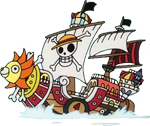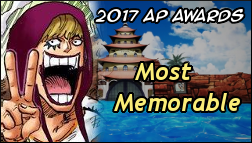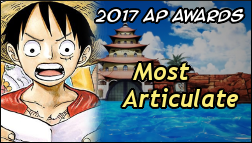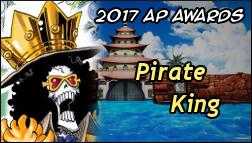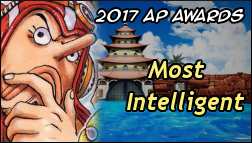@Count:
But what's wrong about listing preferences in terms of arcs? They help highlight the types of things we like and don't like to see in the series, especially when arcs can cover a whole array of topics, locales, and characters with varying execution. It's not like we're comparing completely different genres. This is still one big series that always has some form of consistency thematically and characterization-wise. Sagas are WAY too broad to critique, especially when the arcs (despite them linking together some plot threads) are meant to still stand on their own qualitatively in so many regards. Just because a part of a saga is needed for the saga to function does not mean that we still can't have the opinion that said part of the saga was bad or that it could have been done better. Trying to evaluate Alabasta's quality only in the context of acknowledging every other island in the saga is a bit ridiculous with the varying degrees in quality and focus. Arcs should be re-readable on their own without needing other arcs to be sequentially read for them to have merits. Which, unfortunately, is Zou's flaw (which Daz pointed out). Why can't we judge by both story arc and saga perspectives individually? It doesn't have to just always be one or the other.
Yeah this last line is a good point. There's different times for different things, plus personal preferences, and I seem to have different preferences to most.
That said, I know that Oda does his best, even in a larger storyline, to give each location visited its own plot open and closed plot thread, but that hardly makes them standalone. If Zou is flawed for being deeply entrenched in large plot threads that transcend sagas, Marineford too has that flaw. If you tried to pick up Marineford on its own merits you'd be pretty lost as to why Luffy is where he is and why he's traveling with all these former enemies, as well as all the emotional build up that gave needing to save Ace weight as a plot point. You'd be lost if you hadn't read Impel Down, and even then the opening of that arc, with Luffy apart from his crew and working with Hancock, hinges entirely on Amazon Lilly having happened, and you need Sabaody to know how he got there. None of these stand properly on their own. You need a working memory of what's come before. If someone came from you with a clean slate, asking for a jumping in point for the best One Piece storyline, you wouldn't start them at Marineford. You would have them go at least from Sabaody. Similarly, if you thought Ennies Lobby was OP at its best you'd have a new reader start at Water Seven or even Long Ring. Skypiea falls apart at the end because its emotional climax with the bell needs context from Jaya as well as the flashback in its own arc. Even Alabasta, while easier to take as a starting point, does ride on four other arcs' worth of Vivi's characterisation and Baroque Works building as a an enemy force. In this case you don't need to have seen all the preceding encounters with BW agents to understand them and their deal, but it helps paint them as a credible threat. (Which is something the Donquixote Family might have been helped by.) Anyone who thinks Zou was crippled by its need for context has forgotten how many great parts of this story have relied on the islands preceding them.
There is no need for arcs to be standalone to be good, and writing things to be read standalone hasn't been Oda's policy for a long time. The New World is more interconnected and complex than the first half of the story, with Big Mom and Kaido tagging in and out as primary threats between sagas. Fishman Island was Big Mom's turf, then Punk Hazard and Dressrosa were connected to Kaido's operation (with a cameo from Big Mom's ship in the middle so you don't forget her), then Zou and Totland build towards a climactic Big Mom encounter (with kaido goons as a bait and switch in the early stages of Zou) before we finally sail for Wano to battle Kaido one last time. It's been alternating, but the fact that each group has been building themselves up constantly, even during arcs the other is more central to, makes One Piece harder than ever to read out of sequence. (Maybe Viz was onto something when they decided to collect it all under the New World banner…)
Basically if think arcs propped up by what came before are bad, you must be utterly dreading Wano, what with Law's involvement, the samurai trio and Momo, the Minks, half the crew being there already and the possibility of the Whitebeard Pirates' involvement all going back to varying degrees through every arc since Punk Hazard.
The Straw Hats struggling in some sort of fashion in the New World had to happen. The execution of it needing to result in a Marineford-scale war made up of newly introduced characters left and right from so many different factions is what didn't need to happen in the context of Dressrosa alone. But it did because Oda wanted to put the long game ahead of Dressrosa's qualitative integrity as an individual arc. Thus making it a sacrificial lamb like I said earlier.
I REALLY don't think it's wise to judge sagas by story pyramid progression. Because each arc is supposed to have those narrative elements. Every beginning of a new arc is mostly meant to be a clean slate despite the loose threads that may tie into other arcs that are seen previously or afterwards. I like what you're saying on the subject of Luffy's convictions getting pushed to the edge by Doflamingo. Which is why I wish Bellamy died at the hands of Luffy, so that Doffy would have pushed Luffy to a breaking point where he had no choice. But that type of thing is never going to happen in a series written by Eiichiro "I detest death" Oda.
Except that Dressrosa did not need to be a full-on war for it to have reasonable stakes. It just needed to be akin to Alabasta and Enies Lobby in terms of chaos and named players/factions.
What were Alabasta and Enies Lobby if not smaller Marinefords? All three battles featured factions large enough to have hoards of generic nameless underlings to throw at each other, not to mention the number of named participants. All three featured multiple factions with different goals and motivations in alliances of varied solidity. Marineford was just the next step up in Oda writing large, complex battles. By the time Dressrosa was happening the story was overdue for one, and waiting for Wano would have but it too far off, should Dressrosa have only been a small affair. It's logical for him as an author to make the next one bigger again, and the other after bigger than that. It's logical for us as readers to expect that also. He tried the wrong things with Dressrosa, but he did try things, and we can only hope he learns from the flaws of that arc when he writes Wano, and moreso when he writes Raftel.
The other reason a large battle was important to have was for the Strawhats reputation in-universe. The Grand Fleet that came of this is one thing that could play into Wano possibly, but the spotlight shone on the crew by Issho when he made public the destruction of Dressrosa is something else. It seems Wano and the Reverie will be simultaneous, and their participation in such a large and destructive battle is just the plot device to make the Strawhats a key talking point for the world leaders. It's an event that's put the crew unequivocally on the world stage in a way far greater than the stories coming out of Sabaody and Fishman island of their return, or an appearance on an underworld broadcast on Punk Hazard couldn't. This is why Dressrosa needed to be big and why having something big couldn't wait until Wano.
Look, I think that from a narrative and story structure perspective, Dressrosa needed to be big; you disagree, and that's fine. But clearly we both agree that whatever that arc was meant to be it failed in a whole lot of ways, and isn't that the most important thing? I feel like we're just going to go in circles if we keep pushing this debate.
That doesn't work at all. Whole Cake Island, as focused as it seems to be towards Big Mom, is really meant to gear up the difficulty and narrative importance of Wano Country. Especially since the purpose of why Luffy went there is to rescue Sanji, and will come back with Jimbei in tow to help with the war in Wano Country. Barely any arcs flow stylistically. I fail to see how an island with prehistoric dinosaurs and a snowy mountainous island connected to a desert country. Their only links were having Baroque Agent antagonists (aside from Drum. It doesn't connect at all with Alabasta aside from Vivi having a cool moment of showing off her diplomatic ability needed for becoming a ruler). And that is what ties Zou, Totland, and Wano Country together (along with Dressrosa, Punk Hazard, and even Fishman Island). The Straw Hats having to constantly juggle between Big Mom and Kaido. Not to mention the links that those two characters share in both of them wanting Caesar Clown to realize their dreams and having some sort of mysterious connection to Giants.
It doesn't get more obvious than that. Oda himself doesn't really give a clear outline as to exactly when an arc ends or begins, and I doubt he does the same for sagas. If anything, you can look at Totland as the Drum Island of this saga in how it seems contained, but it still meant to noticeably build-up to a bigger arc in how it gains forces in the form of a new Straw Hat.
I suppose this is where it gets complicated, what with alternating Big Mom and Kaido as villains like I was talking about above. They're both still building when the other is a focus, so it gets harder to pry their story threads apart. Since there's no real formal, official or canon definition for saga and arc start and end points (oh to have Jojoesque parts to ease discussion), it really comes down to personal interpretation and preference where each person wants to break up the story.
You've got your own opinions, and I respect that, but let me lay down my line of thinking for Zou/Totland being its own thing.
See, the Strawhats have been put on a fast track to fighting Kaido, going from Punk Hazard to Dressrosa to Wano, as the pages you posted point out, but that's thing with Totland, isn't it? It's not part of that ride. Look how frustrated Zoro is that they have to delay the battle and deviate from the plan here, and not just because it's Sanji's fault, because he takes seriously that they're on the road to Wano, and Totland isn't part of that road. It's a detour, a personal sidequest, and it puts a whole other villain who's supposed to be Kaido's equal in the spotlight. Not only that, Totland has some pretty distinct theming to pay attention to. It's all about family ties. Sanji struggling with his connections, both formal and emotional, to the Vinsmokes. Big Mom roping people into her crew permanently by making them family. We're taking a look at what obligations exactly being tied by blood to a person gives you, and how hard it is to sever a tie of that kind. The Vinsmoke kids literally can't disobey their father. We also see how being tied by blood doesn't guarantee safety, even if you stay. The Vinsmokes sacrifice Sanji in marriage, and the clones don't care about the deaths of their own, even though they're all technically siblings also. Big Mom is completely willing to kill her own children. Opera confirmed that it doesn't just happen by accident during hunger rampages when he feared it as a punishment. Reiju and Sanji discuss the fall of the Vinsmoke family and their kingdom. Capone married into Big Mom's family but still plots against her. Family binds rather absolutely, but guarantees no safety nor loyalty.
In contrast to this we have the minks and samurai on Zou. There's no blood or marriage connecting the Koizuki Clan and the Mokomo Dukedom, but Raizo's safety was a given on Zou, even against his will. The minks were loyal enough to fight to the last man for a single ally, all out of respect and honour. The Strawhats' affection and loyalty is the same way, and that's what's gonna save Sanji from the terror of his blood family. The blood of the covenant is thicker than the water of the womb seems to be the message Oda is building to here, with a little extra on how the water of the womb can really suck sometimes.
You might argue that friendship and loyalty as themes are prevalent through all of One Piece, and you'd be right. But they haven't been contrasted with the idea of family ties quite like this before, and the family theme is just everywhere in Totland. Sanji's family, Big Mom's extended family, the army of clones meaning that every citizen of Germa Kingdom is blood related, this is an isolated and intense block of theming that stands out from the stories on either side of it.
How do we know these themes won't carry on into Wano? Because we have a pretty good idea of what the Wano story is going to focus on. The goal is to open Wano's borders, which is a whole can of worms to do with nationalism and national security, cultural segregation and freedom, as well as seating a rightful royal family back on their throne. The family theme will be wrapped up in Totland so we can think about all that stuff I just mentioned. And for that reason, as well as it being part of the Big Mom focused collection of alternating sagas, is why we'll look back on the Totland Saga as a unique entity to the Wana Saga.
Remember that the wiki used to count Thriller Bark as the first arc of the Marineford Saga instead of as its own thing. These definitions, even in the public mind, aren't set in stone.
You can disagree with all this if you like or you can not, it's just how I see the story and my views on story structure.
I fail to see how an island with prehistoric dinosaurs and a snowy mountainous island connected to a desert country. Their only links were having Baroque Agent antagonists (aside from Drum. It doesn't connect at all with Alabasta aside from Vivi having a cool moment of showing off her diplomatic ability needed for becoming a ruler).
You don't think a guest crewmate and a reoccurring antagonist team is a pretty strong tie to work with? Yes, things presently are a lot more complex with more guests coming and going and overstaying the ends of sagas, and yeah there was a lot less in the way of narrative theming in those older days. But the ongoing narrative threads of Baroque Works and Vivi and the need to reach Alabasta drove the islands preceding it. Drum may not have had BW antagonists, but it opens with the crew seeing a newspaper reporting on the civil war. When Nami gets sick it's a real debate whether to stop and seek treatment or sail straight to Alabasta. Who cares that the islands don't line up aesthetically? That's pretty irrelevant in a world as varied and unpredictable as OP's.
The story structure was simpler in the days of Baroque Works. It's easy to make a saga from that period just based on the first appearance and subsequent fall of BW. Much easier than trying to find whole story threads in a part of the series with two Emperors who have been jostling for the role of end villain for 24 volumes (rounding down to the start of the Fishman Island Saga). Things just aren't like they were then
Except that we didn't need a whole "practice" war for the war in Wano Country. If anything, not having Dressrosa be such a huge warzone and much more contained while still maintaining high struggles and stakes for the Straw Hats would have helped make Wano Country feel more unique and dynamic in the plot. But I'm glad you agree on those points though. It should have worked more akin to the Baroque Works style. And that;s sort of what Oda was trying to do by having Punk Hazard star Vergo and Monet as well as directly leading into Law holding Doflamingo at bay with a ransom for Caesar. But we could have gotten more than that. Especially if Oda was willing to let Doflamingo not be restricted solely to Dressrosa just because. I mean, the dude can fly.
It's all "practice" for Raftel anyway, right? Seriously though, practice isn't the right word, it's all a case of logical serial escalation. But I think I covered all my thoughts on the need for Dressrosa to try to be big above. So yeah, Baroque Works style could have worked. Even just making Green Bit its own thing would have made such a difference with hardly any need to alter the characters involved in the saga. Alas, we got what we got. It had its moments, it had its flaws, but there's no taking it back now. As Doflamingo might say, "It's reality now! It happened! So I forgive Oda for it!"
And anyway, I've quite liked everything that's come since. Zou was well paced, had a unique structure in unraveling the main action of the story through flashbacks, piece by piece, and subverted all expectations in its ending. It built a lot of hype for the future while still having its own identity. Plus it was astonishingly brief. Totland has had issues so far with only showing the beginning and end of certain encounters and fights, skipping out midsections entirely. I think this is a bad habit Oda built while trying to cut down his script to just the most exciting bits to shorten Dressrosa. But aside from that the arc has featured interesting settings and characters, and has been paced pretty smoothly.


